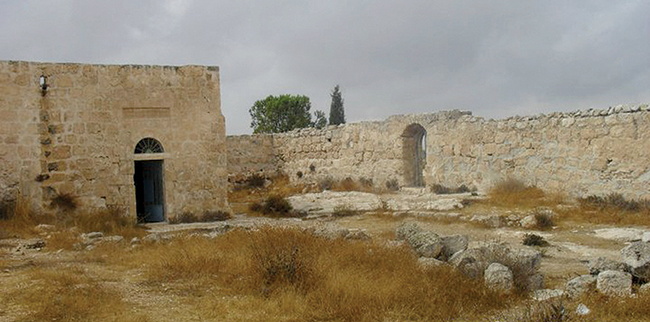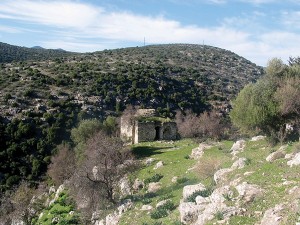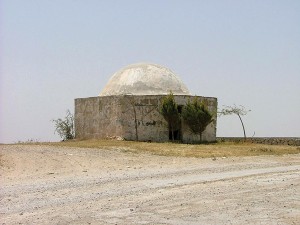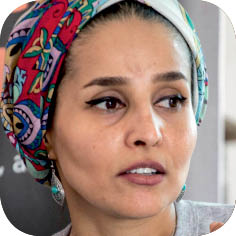
I have to admit that, despite the fact that I have lived in Palestine most of my life, it was only last year that I first visited Nabi Musa, an ancient shrine and mosque located near Jericho. I remember that I was speechless while I was exploring the site, which is said to house the grave of the Prophet Moses. I had so many questions flashing through my mind: Why is such a site almost abandoned? Why is it only now that I am visiting? Why are these rooms empty? What is the plan of the Ministry of Tourism for a site as remarkable as Nabi Musa?
This was actually not the first time I was devastated by an abandoned shrine in Palestine, as I have come across a number of Sufi shrines and sacred sites in different places in the West Bank in the past few years. Most of the time, I decide to stop and walk around the sites so I can see how lonesome, unfriendly, and gloomy these places have become. Some of them have been converted into landfills, some seem to have been intentionally damaged, and most of them have been vandalized with ugly graffiti. I always ask myself, why on earth have we abandoned these places? It is very obvious that they were once beautiful places with their own unique history, and that there is no good reason for converting them into these miserable ruins. After every experience at an abandoned shrine, I remember those humble archaeological sites I visited in the UK on organized tours. The British people embrace every tiny trail, even if it is no more than three small rocks spread across two square meters. It is quite painful to me that we do not embrace our remarkable heritage in Palestine.
♦ It is time to reconsider the tourism policies in Palestine and give some attention to the abandoned shrines and sacred sites scattered around the country. There are plenty of exciting and educational stories that can be told about these places and there is a rich history that can be revived.
Nabi Musa is no exception, but the site has been a little bit more privileged because it has a mosque inside where people maintain regular daily prayers, and because the Turkish government has an interest in restoring the annual Nabi Musa pilgrimage that first started in the twelfth century during the time of Saladin. It is believed that Saladin established this annual pilgrimage after the conquest of Jerusalem in 1187 in order to outnumber Christian pilgrims during Easter, and that it was maintained afterwards, especially during the British Mandate, as a political event in addition to a religious pilgrimage.

The Israeli Occupation banned the celebration of the yearly pilgrimage in the wake of the Second Intifada in 2000. However, Turkish interest in the site led to a visit in April 2014 by the Turkish Cooperation and Coordination Agency (TIKA) that included the Turkish ambassador to the occupied Palestinian territories accompanied by the governors of Jerusalem, Ramallah, and Jericho. Their goal was to renew the yearly pilgrimage after more than ten years of interruption. The visit included Sufi scouts, recitation of the Quran, and speeches. The visit was followed by a memorandum of understanding between the Palestinian Ministry of Tourism and the Ministry of Islamic Endowments (Awqaf) to renovate and revive the site.
However, more effort is needed to actually breathe life into the place. For example, instead of limiting the annual pilgrimage to Muslims only, the event could involve non-Muslims by expanding it to include other entertaining yet appropriate activities, given that Nabi Musa is a sacred place. The renovation could include rehabilitation of the vacant rooms in the site to house tourists overnight. Other rooms and facilities might be added to the site in order to increase its capacity and make space for more activities that cannot be done next to the mosque, yet are appropriate to do nearby, such as Sufi dancing and singing, poetry, and quizzes.

Similarly, there are dozens of abandoned shrines scattered across the West Bank that nobody cares about or tries to do anything about, gauging by their current state. From the tourism angle, it is mandatory that a root cause analysis be conducted in order to dig up the real reasons for abandoning these sites and suggest solutions to give a new lease on life to these forgotten sanctuaries. I should mention here some obvious causes such as the prolonged Occupation that has changed our priorities, as well as the gradual invasion over the past few decades of a religious ideology that holds a negative attitude towards the concept of shrines.
Reviving the abandoned shrines might be accomplished as a national tourism project to attract local and international tourism. The Palestinian Authority would need to highlight the project as a part of the Palestinian struggle against the Israeli Occupation and also to underscore the revival of shrines as restoring a part of the county’s history, which would not require local people to be Sufis in order to be able to visit the sites. In fact, many options for giving life to the shrines need to be examined, so that the government in Palestine can start with a solid plan for building successful spiritual tourism in Palestine. The people of Palestine as well as the people around the world need to know that we have remarkable spiritual sites in addition to the Dome of the Rock and the Nativity Church. The holy land of Palestine has amazing heritage that needs to be spoken about.
» Ahlam Tarayra is an Operations Manager at Smart Events and Marketing in Ramallah. She spent eight years working in the non-profit sector as a humanitarian professional. After getting involved in the marketing industry, Ahlam started to spot genuine opportunities for tourism promotion in Palestine.


